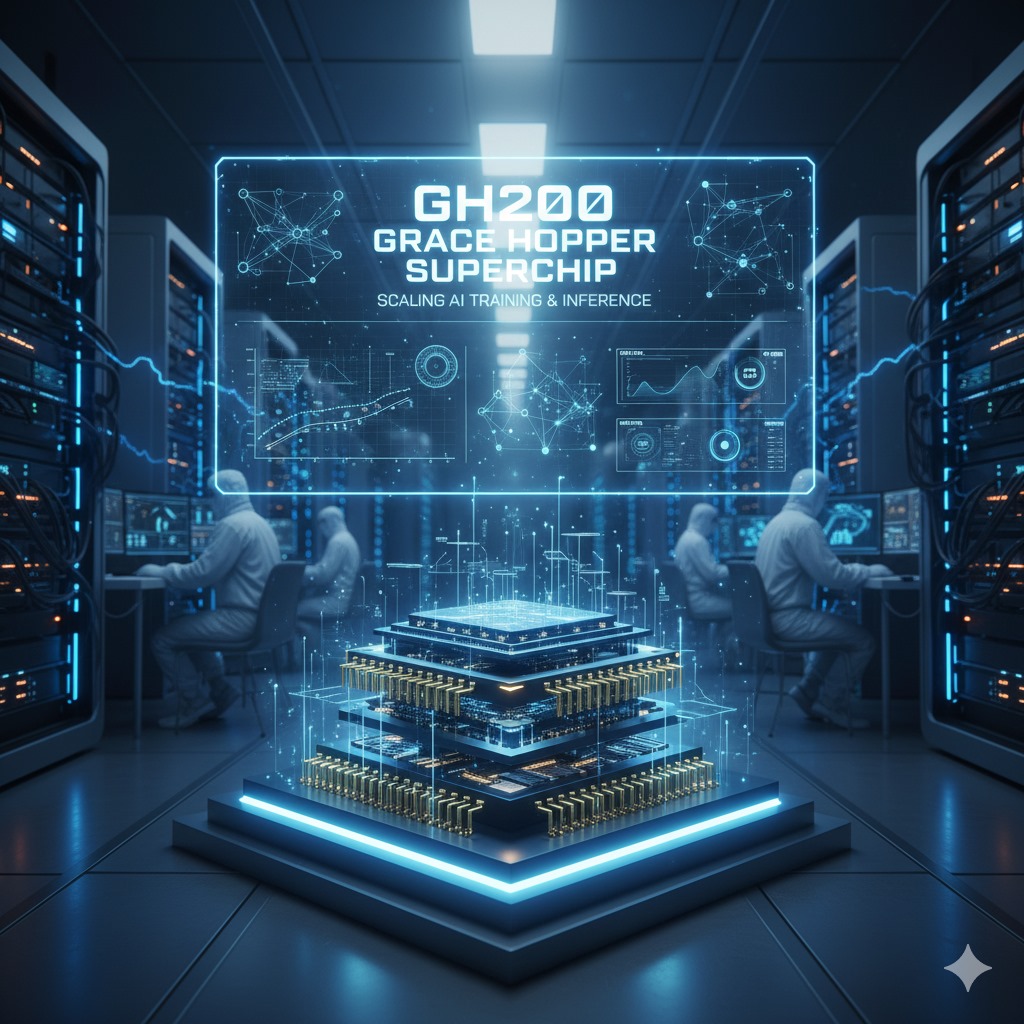Overview: What the GH200 Grace Hopper superchip is
NVIDIA announced the GH200 Grace Hopper superchip as a purpose-built platform to support very large AI models by combining its Grace CPU architecture with Hopper GPUs. The superchip is presented as a structural advance to increase memory bandwidth and enable better multi-node scalability for both training and inference workloads [1][2].
Why this matters for businesses
Large-scale AI models — from generative language models to multimodal systems — are increasingly constrained by memory capacity, memory bandwidth and the efficiency of communication between compute nodes. The GH200 targets these bottlenecks by integrating CPU and GPU capabilities into a single superchip architecture that improves data movement and multi-node coherence, with the explicit goal of making very large models more practical to train and deploy [1][2].
Business value in plain terms
- Faster iteration on model training: Reduced data transfer overhead and higher memory bandwidth shorten training time for large models.
- Cost efficiency at scale: More efficient scaling across nodes can lower compute hours needed for the same workloads.
- On-premises viability: Organizations that must keep sensitive data in-house can gain hardware optimized for very large models.
Technical strengths (from the announcement)
According to NVIDIA’s announcement and coverage, the defining technical attributes of the GH200 are its integration of the Grace CPU with Hopper GPU technology and an architecture designed to raise memory bandwidth and enable improved coherence across multiple nodes. These improvements are aimed directly at the needs of very large model training and inference, where capacity and interconnectivity matter more than single-node raw FLOPS alone [1][2].
What the architecture enables
- Higher effective memory bandwidth for large model states, reducing time spent moving parameters in and out of memory.
- Multi-node coherence and communication improvements that let model partitions scale out more efficiently across systems.
- Better alignment between CPU-managed data workflows and GPU compute, simplifying data pipelines for large workloads.
Practical applications and real-world examples
Enterprises building or operating large language models (LLMs), foundation models or large multimodal systems are the primary beneficiaries. Real-world applications include:
- Training proprietary LLMs for domain-specific knowledge (finance, healthcare, legal) where data cannot be moved to public clouds.
- Large-scale inference for customer-facing products (chat, summarization, personalization) where inference latency and model size are critical.
- Hybrid cloud/on-prem pipelines where certain stages run in secure data centers while others run in public cloud environments.
These use cases align with NVIDIA’s positioning of the GH200 as an accelerator for very large models, enabling organizations to push model size and complexity while maintaining acceptable training and inference performance [1][2].
Actionable steps for business leaders
Adopting new accelerator hardware like the GH200 is a strategic decision. Use this checklist to evaluate readiness and plan adoption:
1. Profile AI workloads
- Identify models constrained by memory bandwidth or multi-node communication.
- Estimate current training and inference costs, bottlenecks and the proportion attributable to inter-node communication.
2. Pilot and benchmark
- Arrange a proof-of-concept with vendor hardware or cloud partners offering GH200-equipped instances.
- Measure end-to-end metrics: throughput, time-to-train, cost-per-epoch and inference latency for target workloads.
3. Align infrastructure and data strategy
- Assess whether workloads should run on-premises (for data governance) or in colocation/cloud environments that provide GH200-based services.
- Plan data pipelines to exploit the tighter CPU–GPU integration the GH200 provides, minimizing redundant data movement.
4. Build skills and governance
- Train ML engineering teams on multi-node training paradigms and memory-optimized model sharding.
- Update procurement, security and model governance policies to include hardware lifecycle and vendor dependency considerations.
Cost and procurement considerations
Adopting high-end accelerators requires a clear total-cost-of-ownership (TCO) analysis. Consider:
- Hardware acquisition vs. cloud instance costs.
- Power, cooling and data-center space for on-prem deployments.
- Support contracts and integration services from vendors or system integrators.
Because the GH200 is positioned to address scaling bottlenecks, its value proposition is strongest where model size or inference demands make current infrastructure inefficient. For smaller models, the incremental benefit may not justify the expense.
Risks and limitations
While the GH200 targets clear technical bottlenecks, decision-makers should weigh several risks:
- Vendor lock-in: Specialized hardware often comes with ecosystem dependencies; diversify procurement strategies.
- Workload fit: Not all workloads benefit equally — memory- or communication-bound jobs benefit more than compute-bound ones.
- Integration complexity: Multi-node systems require sophisticated orchestration and careful tuning of distributed training frameworks.
Mitigation strategies
- Start with pilots and benchmarks to confirm benefits on representative workloads.
- Adopt modular infrastructure designs and containerized ML stacks to ease migration between hardware generations and vendors.
- Work with ecosystem partners (hardware vendors, cloud providers, frameworks) to reduce integration time and operational risk.
Checklist for a 90-day evaluation
- Week 0–2: Inventory models and identify memory/communication bottlenecks.
- Week 3–6: Arrange access to GH200 hardware (vendor lab, cloud instance) and run baseline benchmarks.
- Week 7–10: Compare cost-per-training-job, end-to-end latency and operational overhead against current infrastructure.
- Week 11–12: Decide on pilot expansion, procurement or hybrid deployment strategy.
Conclusion
The GH200 Grace Hopper superchip represents a targeted evolution in accelerator design focused on the pain points of very large AI models: memory bandwidth and multi-node scaling. For enterprises building or operating foundation models where those constraints dominate, the GH200 can be a strategic enabler — but success depends on careful workload profiling, pilot benchmarking and planning for integration and governance. Organizations should validate vendor claims with representative tests and align procurement with long-term data and model strategies [1][2].
References
- [1] NVIDIA: GH200 Grace Hopper superchip announcement — https://blogs.nvidia.com/blog/2025/08/22/gh200-grace-hopper-superchip/
- [2] The Verge coverage of GH200 launch — https://www.theverge.com/2025/8/22/nvidia-gh200-ai-superchip-launch




